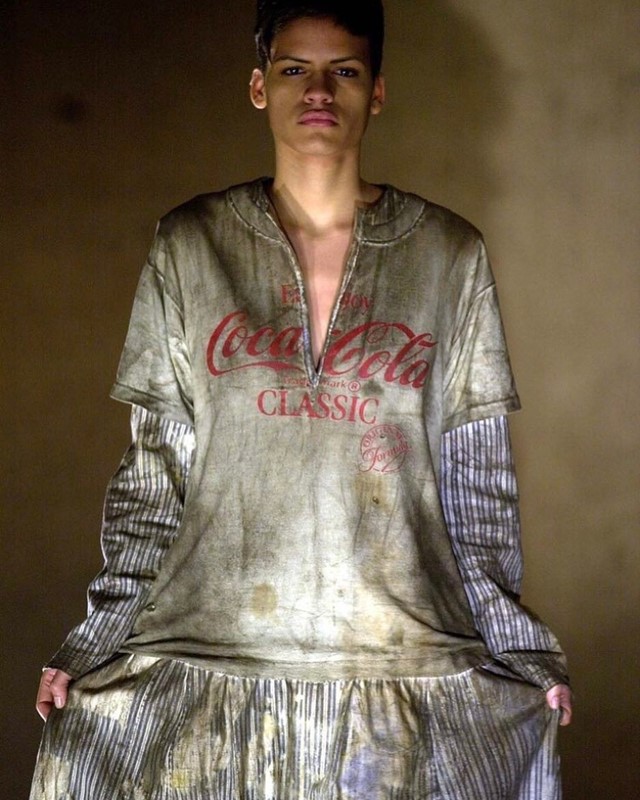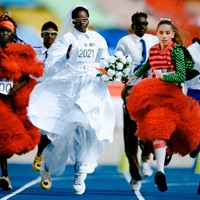The Spanish-born designer famously rehashed Burberry, Louis Vuitton and Ralph Lauren prints for his political label
Design collective Vaquera’s AW18 collection was notable for several reasons. A fusion of religious and casino iconography being one. Dresses emblazoned with their designer idols being another. The fashion foursome reinvigorated the fan tee for 2018, printing the names and faces of Vivienne Westwood, Martin Margiela, Andre Walker and Miguel Adrover onto white polo dresses.
The latter caused a ruckus on social media with industry diehards welcoming a mention of the forgotten talent. But just who is Miguel Adrover, the Spanish designer who caused a Stateside disturbance in the early 00s, before retreating back to his native Majorca?
JUST LIKE MANY REVOLUTIONARIES, HE HAD NO FORMAL FASHION TRAINING
It’s rare for any icon to have a bare Wikipedia page, but Miguel Adrover’s is merely three sentences long. The elusive designer started his life on the Spanish island of Majorca in 1965, quitting school at the age of 12 to work on his family farm. A teen trip to London and meeting with Alexander McQueen gave him a first taste of counterculture.
According to early reports, his interest in fashion began in 1991 when he took a transatlantic flight to New York and decided to stay. There, Adrover became friends with tailor Douglas Hobbs. Both entrepreneurs at heart, the pair decided to make and sell t-shirts before opening up their own boutique, Horn, in the East Village.
Horn took a risk on up-and-coming designers who had nowhere else to show their clothes, attracting several underground names, including McQueen, who by then had become a close friend. Adrover bonded with those struggling to balance the commercial needs of the industry with their own creative vision, and decided to become one of them, closing his store in 1999.
HIS COLLECTIONS WERE COPYRIGHT CHAOS
Pre-Demna Gvasalia, there was Miguel Adrover. Obsessed with commenting on capitalist culture and how society can be swayed by nothing but visuals, he kickstarted an era of logomania.
In September 1999, the fresh face debuted his first collection, ‘Manaus-Chiapas-NYC’. The tale of a woman who landed in the Big Apple by way of an Amazonian tribe, Adrover’s designs were decidedly original (thanks to being cost-friendly cast-offs) and downright bizarre at the time.
Aside from the stand-out anaconda coat and ‘I heart New York’ tulle t-shirt, it was Adrover’s appropriated Louis Vuitton bag that stole the show. Slicing and splicing, he transformed a traditional symbol of wealth into a miniskirt.
Later collections stole the logos of Ralph Lauren, Marlboro and Coca-Cola, throwing them on tees, shirts and baseball vests to make a ‘look at me’ statement. Adrover was causing underground chaos and the press couldn’t get enough.
But his second line, AW00s ‘Midtown’, caught the attention of the wrong people. Set to the sounds of city traffic, Adrover debuted an inside-out Burberry trench coat, revealing the famous heritage check. With only $5 in his pocket, imagine the palpitations at receiving a threatening legal letter from Burberry, warning him not to use its pattern again.
HE’S A CAUTIONARY TALE FOR ANY EMERGING POLITICAL DESIGNER
As many young designers now know, you can’t create a sustainable business without financial backing. Adrover understood this well. The only reason he could afford a second show was thanks to a $2,000 reimbursement from American Vogue after his samples were stolen from one of the magazine’s shoots. Despite several store owners offering to fund his line, Adrover knew he needed more security. And quick.
So when his legally dubious collection earned an investment offer from Pegasus Apparel Group, the designer was happy to accept. Creating sales-driven looks wasn’t on Adrover’s radar, but his clothes were picked up by the likes of Barneys and Neiman Marcus anyway. That year, the Miguel Adrover brand earned $5 million in sales.
Now financially comfortable, Adrover set to work on his tensest collection yet. “Fashion lives in a bubble,” he told the New York Times in 2004. “We’re not going to show pink flower dresses on the catwalk if people are in the world throwing bombs.” Amid increasing concern about the rise of the Taliban, an AW01 Middle Eastern-inspired collection raised some uncomfortable questions, said critic Cathy Horyn.
It was Adrover’s SS02 ‘Utopia’ collection that proved to be his downfall. Shown 48 hours before the Twin Towers fell, Adrover’s ethnic references were accused of romanticising Taliban culture, and even led to a CIA investigation. Of course, Adrover wasn’t to know the atrocity that would occur two days after his show. He later called it “bad timing,” adding: “People got it confused. And I suffered for it.”
This bad timing resulted in Adrover’s backers, Pegasus, going bankrupt, leaving the designer with no option but to cancel retailers’ orders. He took a year off, re-emerging in 2004. But with no financial help, Adrover couldn’t pay for shipment of his latest collections, leading stores to drop his line.
His final New York Fashion Week collection was a rather sorry affair. Adrover revisited his screenprinting roots for his final SS05 bow, wearing a t-shirt that read: “Anyone seen a backer?” Clearly, no one answered his desperate call as shortly after, the man that had so quickly revolutionised the industry was forced to quit New York and move back home to Majorca.
The lesson for future designers? Politics is a tricky business. Make sure you can afford it.
HIS COMEBACK DIDN’T QUITE GO TO PLAN
In 2007, Adrover returned as the creative director of eco-friendly German label Hess Natur. Commerciality was flowing in his veins, as he told FashionEtc.com: “My challenge is to find great eco-friendly materials to work with and design a line that sells, but that the fashion world also recognises.”
After years of failing, Adrover returned to the NYFW schedule in 2012 with a recycled collection. It featured clothes from family members, fabrics found in dumpsters, and a leather skirt reworked from a McQueen-gifted jacket. Models threw Cuban pesos down the catwalk; a critical move that “felt thin”, according to a Vogue review.
It’s unclear what Adrover is up to right now. In September, he wrote on Instagram: “The DESIGNER Miguel Adrover is dead.” Was he signalling a career change? Or a return to anonymity? Who knows? One thing that is clear, though, is that the Adrover of today is a fashion fan no longer, telling Bidoun: “What is fashion really about now? It’s almost totally superficial. So frivolous and so capitalist that it isn’t even interesting.”




